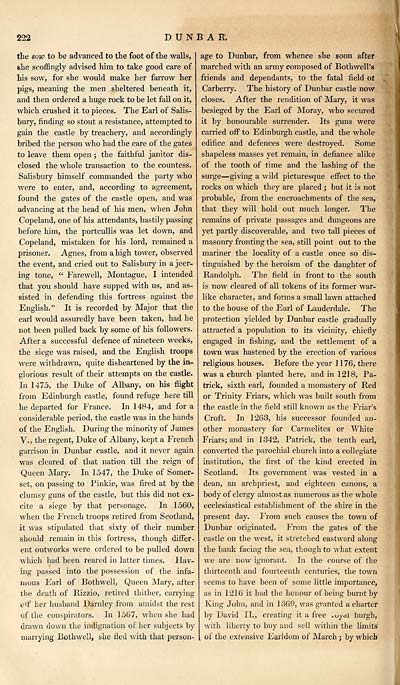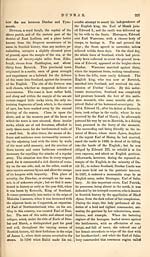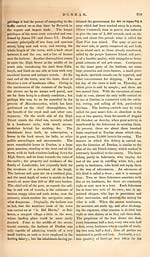Gazetteer of Scotland > Volume 1
(252) Page 222 - DUN
Download files
Complete book:
Individual page:
Thumbnail gallery: Grid view | List view

222
DUNBAR.
the sow to be advanced to the foot of the walls,
ehe scoffingly advised him to take good care of
his sow, for she would make her farrow her
pigs, meaning the men sheltered beneath it,
and then ordered a huge rock to be let fall on it,
which crushed it to pieces. The Earl of Salis-
bury, finding so stout a resistance, attempted to
gain the castle by treachery, and accordingly
bribed the person who had the care of the gates
to leave them open ; the faithful janitor dis-
closed the whole transaction to the countess.
Salisbury himself commanded the party who
were to enter, and, according to agreement,
found the gates of the castle open, and was
advancing at the head of his men, when John
Copeland, one of his attendants, hastily passing
before him, the portcullis was let down, and
Copeland, mistaken for his lord, remained a
prisoner. Agnes, from a high tower, observed
the event, and cried out to Salisbury in a jeer-
ing tone, " Farewell, Montague, I intended
that you should have supped with us, and as-
sisted in defending this fortress against the
English." It is recorded by Major that the
earl would assuredly have been taken, had he
not been pulled back by some of his followers.
After a successful defence of nineteen weeks,
the siege was raised, and the English troops
were withdrawn, quite disheartened by the in-
glorious result of their attempts on the castle.
In 1475, the Duke of Albany, on his flight
from Edinburgh castle, found refuge here till
he departed for France. In 1484, and for a
considerable period, the castle was in the hands
of the English. During the minority of James
V., the regent, Duke of Albany, kept a French
garrison in Dunbar castle, and it never again
was cleared of that nation till the reign of
Queen Mary. In 1547, the Duke of Somer-
set, on passing to Pinkie, was fired at by the
clumsy guns of the castle, but this did not ex-
cite a siege by that personage. In 1560,
when the French troops retired from Scotland,
it was stipulated that sixty of their number
should remain in this fortress, though differ-
ent outworks were ordered to be pulled down
which had been reared in latter times. Hav-
ing passed into the possession of the infa-
mous Earl of Bothwell, Queen Mary, after
the death of Rizzio, retired thither, carrying
otf her husband Darnley from amidst the rest
of the conspirators. In 15G7, when she had
drawn down the indignation of her subjects by
marrying Bothwell, she fled with that person-
age to Dunbar, from whence she soon after
marched with an army composed of Bothwell's
friends and dependants, to the fatal field ot
Carberry. The history of Dunbar castle now
closes. After the rendition of Mary, it was
besieged by the Earl of Moray, who secured
it by honourable surrender. Its guns were
carried off to Edinburgh castle, and the whole
edifice and defences were destroyed. Some
shapeless masses yet remain, in defiance alike
of the tooth of time and the lashing of the
surge — giving a wild picturesque effect to the
rocks on which they are placed ; but it is not
probable, from the encroachments of the sea,
that they will hold out much longer. The
remains of private passages and dungeons are
yet partly discoverable, and two tall pieces of
masonry fronting the sea, still point out to the
mariner the locality of a castle once so dis-
tinguished by the heroism of the daughter of
Randolph. The field in front to the south
is now cleared of all tokens of its former war-
like character, and forms a small lawn attached
to the house of the Earl of Lauderdale. The
protection yielded by Dunbar castle gradually
attracted a population to its vicinity, chiefly
engaged in fishing, and the settlement of a
town was hastened by the erection of various
religious houses. Before the year 1 1 76, there
was a church planted here, and in 1218, Pa-
trick, sixth earl, founded a monastery of Red
or Trinity Friars, which was built south from
the castle in the field still known as the Friar's
Croft. In 1263, his successor founded an-
other monasteiy for Carmelites or White
Friars; and in 1342, Patrick, the tenth earl,
converted the parochial church into a collegiate
institution, the first of the kind erected in
Scotland. Its government was vested in a
dean, an archpriest, and eighteen canons, a
body of clergy almost as numerous as the whole
ecclesiastical establishment of the shire in the
present day. From such causes the town of
Dunbar originated. From the gates of the
castle on the west, it stretched eastward along
the bank facing the sea, though to what extent
we are now ignorant. In the course of the
thirteenth and fourteenth centuries, the town
seems to have been of some little importance,
as in 1216 it had the honour of being burnt by
King John, and in 1369, was granted a charter
by David II., creating it a free .u^ai burgh,
with liberty to buy and sell within the limits
of the extensive Earldom of March ; by which
DUNBAR.
the sow to be advanced to the foot of the walls,
ehe scoffingly advised him to take good care of
his sow, for she would make her farrow her
pigs, meaning the men sheltered beneath it,
and then ordered a huge rock to be let fall on it,
which crushed it to pieces. The Earl of Salis-
bury, finding so stout a resistance, attempted to
gain the castle by treachery, and accordingly
bribed the person who had the care of the gates
to leave them open ; the faithful janitor dis-
closed the whole transaction to the countess.
Salisbury himself commanded the party who
were to enter, and, according to agreement,
found the gates of the castle open, and was
advancing at the head of his men, when John
Copeland, one of his attendants, hastily passing
before him, the portcullis was let down, and
Copeland, mistaken for his lord, remained a
prisoner. Agnes, from a high tower, observed
the event, and cried out to Salisbury in a jeer-
ing tone, " Farewell, Montague, I intended
that you should have supped with us, and as-
sisted in defending this fortress against the
English." It is recorded by Major that the
earl would assuredly have been taken, had he
not been pulled back by some of his followers.
After a successful defence of nineteen weeks,
the siege was raised, and the English troops
were withdrawn, quite disheartened by the in-
glorious result of their attempts on the castle.
In 1475, the Duke of Albany, on his flight
from Edinburgh castle, found refuge here till
he departed for France. In 1484, and for a
considerable period, the castle was in the hands
of the English. During the minority of James
V., the regent, Duke of Albany, kept a French
garrison in Dunbar castle, and it never again
was cleared of that nation till the reign of
Queen Mary. In 1547, the Duke of Somer-
set, on passing to Pinkie, was fired at by the
clumsy guns of the castle, but this did not ex-
cite a siege by that personage. In 1560,
when the French troops retired from Scotland,
it was stipulated that sixty of their number
should remain in this fortress, though differ-
ent outworks were ordered to be pulled down
which had been reared in latter times. Hav-
ing passed into the possession of the infa-
mous Earl of Bothwell, Queen Mary, after
the death of Rizzio, retired thither, carrying
otf her husband Darnley from amidst the rest
of the conspirators. In 15G7, when she had
drawn down the indignation of her subjects by
marrying Bothwell, she fled with that person-
age to Dunbar, from whence she soon after
marched with an army composed of Bothwell's
friends and dependants, to the fatal field ot
Carberry. The history of Dunbar castle now
closes. After the rendition of Mary, it was
besieged by the Earl of Moray, who secured
it by honourable surrender. Its guns were
carried off to Edinburgh castle, and the whole
edifice and defences were destroyed. Some
shapeless masses yet remain, in defiance alike
of the tooth of time and the lashing of the
surge — giving a wild picturesque effect to the
rocks on which they are placed ; but it is not
probable, from the encroachments of the sea,
that they will hold out much longer. The
remains of private passages and dungeons are
yet partly discoverable, and two tall pieces of
masonry fronting the sea, still point out to the
mariner the locality of a castle once so dis-
tinguished by the heroism of the daughter of
Randolph. The field in front to the south
is now cleared of all tokens of its former war-
like character, and forms a small lawn attached
to the house of the Earl of Lauderdale. The
protection yielded by Dunbar castle gradually
attracted a population to its vicinity, chiefly
engaged in fishing, and the settlement of a
town was hastened by the erection of various
religious houses. Before the year 1 1 76, there
was a church planted here, and in 1218, Pa-
trick, sixth earl, founded a monastery of Red
or Trinity Friars, which was built south from
the castle in the field still known as the Friar's
Croft. In 1263, his successor founded an-
other monasteiy for Carmelites or White
Friars; and in 1342, Patrick, the tenth earl,
converted the parochial church into a collegiate
institution, the first of the kind erected in
Scotland. Its government was vested in a
dean, an archpriest, and eighteen canons, a
body of clergy almost as numerous as the whole
ecclesiastical establishment of the shire in the
present day. From such causes the town of
Dunbar originated. From the gates of the
castle on the west, it stretched eastward along
the bank facing the sea, though to what extent
we are now ignorant. In the course of the
thirteenth and fourteenth centuries, the town
seems to have been of some little importance,
as in 1216 it had the honour of being burnt by
King John, and in 1369, was granted a charter
by David II., creating it a free .u^ai burgh,
with liberty to buy and sell within the limits
of the extensive Earldom of March ; by which
Set display mode to: Large image | Transcription
Images and transcriptions on this page, including medium image downloads, may be used under the Creative Commons Attribution 4.0 International Licence unless otherwise stated. ![]()
| Gazetteers of Scotland, 1803-1901 > Gazetteer of Scotland > Volume 1 > (252) Page 222 - DUN |
|---|
| Permanent URL | https://digital.nls.uk/97427386 |
|---|
| Description | Volume I: Abbey to Glenartney. |
|---|---|
| Attribution and copyright: |
|
| Description | By Robert Chambers and William Chambers. Glasgow: Blackie & Son, 1838. 2 volumes. |
|---|---|
| Shelfmark | NF.1461.g.7 |
| Additional NLS resources: | |

